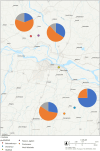Knockdown resistance mutations in Phlebotomus argentipes sand flies in Bihar, India
- PMID: 39123254
- PMCID: PMC11311910
- DOI: 10.1186/s13071-024-06424-0
Knockdown resistance mutations in Phlebotomus argentipes sand flies in Bihar, India
Abstract
Background: Vector control based on indoor residual spraying (IRS) is one of the main components of the visceral leishmaniasis (VL) elimination programme in India. Dichlorodiphenyltrichloroethane (DDT) was used for IRS until 2015 and was later replaced by the synthetic pyrethroid alpha-cypermethrin. Both classes of insecticides share the same target site, the voltage-gated sodium channel (Vgsc). As high levels of resistance to DDT have been documented in the local sand fly vector, Phlebotomus argentipes, it is possible that mutations in the Vgsc gene could provide resistance to alpha-cypermethrin, affecting current IRS pyrethroid-based vector control.
Methods: This study aimed to compare frequencies of knockdown resistance (kdr) mutations in Vgsc between two sprayed and two unsprayed villages in Bihar state, India, which had the highest VL burden of the four endemic states. Across four villages, 350 female P. argentipes were collected as part of a 2019 molecular xenomonitoring study. DNA was extracted and used for sequence analysis of the IIS6 fragment of the Vgsc gene to assess the presence of kdr mutations.
Results: Mutations were identified at various positions, most frequently at codon 1014, a common site known to be associated with insecticide resistance in mosquitoes and sand flies. Significant inter-village variation was observed, with sand flies from Dharampur, an unsprayed village, showing a significantly higher proportion of wild-type alleles (55.8%) compared with the three other villages (8.5-14.3%). The allele differences observed across the four villages may result from selection pressure caused by previous exposure to DDT.
Conclusions: While DDT resistance has been reported in Bihar, P. argentipes is still susceptible to pyrethroids. However, the presence of kdr mutations in sand flies could present a threat to IRS used for VL control in endemic villages in India. Continuous surveillance of vector bionomics and insecticide resistance, using bioassays and target genotyping, is required to inform India's vector control strategies and to ensure the VL elimination target is reached and sustained.
Keywords: Phlebotomus argentipes; kdr mutations; Insecticide resistance; Vector surveillance; Visceral leishmaniasis.
© 2024. The Author(s).
Conflict of interest statement
The authors declare no competing interests.
Figures


References
-
- World Health Organization. Global vector control response 2017–2030. Geneva: World Health Organization; 2017.
-
- Ruiz-Postigo JA, Jain S, Madjou S, Agua JFV, Maia-Elkhoury AN, Valadas S, et al. Global leishmaniasis surveillance, 2022: assessing trends over the past 10 years. World Health Organization—Weekly epidemiological record. 2023;40:471–88.
-
- World Health Organization. Process of validation of elimination of kala-azar as a public health problem in South-East Asia. New Delhi: World Health Organization, Regional Office for South-East Asia; 2016.
MeSH terms
Substances
Grants and funding
LinkOut - more resources
Full Text Sources
Research Materials
Miscellaneous

